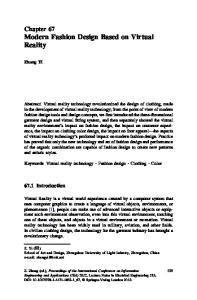Adaptive QP offset selection algorithm for virtual reality 360-degree video based on CTU complexity
- PDF / 6,390,014 Bytes
- 17 Pages / 439.37 x 666.142 pts Page_size
- 51 Downloads / 224 Views
Adaptive QP offset selection algorithm for virtual reality 360-degree video based on CTU complexity Zhi Liu 1 & Ke Yang 1 & Xianya Fu 2 & Mengmeng Zhang 1 & Zhao Wang 3 & Fuqi Mao 1 Received: 20 April 2020 / Revised: 10 August 2020 / Accepted: 16 September 2020 # Springer Science+Business Media, LLC, part of Springer Nature 2020
Abstract
Virtual reality 360-degree video requires ultra-high resolution to provide realistic feeling and dynamic perspective. Huge data volume brings new challenges to coding and transmission. Quantization parameter (QP) is one of the key parameters to control output bitrate and reconstruction quality during coding process. Many QP offset selection algorithms designed for this kind of video are based on latitude or Equirectangular Projection (ERP) weight maps, which cannot adapt to the situation of the flat block in tropical area or the complex block in polar area. In this paper, a new metric to measure complexity of Coding Tree Unit (CTU) is designed, and an adaptive QP offset selection algorithm is proposed based on CTU complexity to improve the quantization process. Each CTU is classified into one of the five categories according to its complexity, and then different QP offset value is determined for each category. By improving the quality of the visually sensitive area and reducing the bitrate of the flat one, the efficiency of the encoder is improved. The experimental results show that, compared with the HM16.20, the WS-PSNR increases by 0.40 dB, the BD-rate reduces by 1.99%, and the quality of visually sensitive areas has improved significantly. Keywords Virtual reality . 360-degree video . QP offset selection . CTU complexity
* Zhi Liu [email protected] * Mengmeng Zhang [email protected]
1
School of Information Science and Technology, North China University of Technology, Beijing 100041, China
2
Yi Xinda (Beijing) Technology Co., Ltd, Beijing 100080, China
3
Institute of Information Science, Beijing Jiaotong University, Beijing 100044, China
Multimedia Tools and Applications
1 Introduction Virtual reality 360-degree video (hereinafter referred to as 360-degree video) requires ultra-high resolution to provide realistic feeling and dynamic perspective [11]. The huge amount of data presents challenges to coding and transmission. In the Equirectangular Projection (ERP) format, the 360-degree video image is stretched to varying degrees, generating a lot of redundant data, which significantly affects encoding performance [2, 9, 21]. Therefore, researches on coding optimization of 360-degree video have received widespread attention. In order to improve coding performance, an adaptive quantization parameter (QP) offset selection algorithm based on Coding Tree Unit (CTU) complexity is proposed to optimize the quantization process in High Efficiency Video Coding (HEVC). The main research contents and innovations are as follows: The characteristics of video images in the ERP projection format are researched, a new metric for measuring CTU complexity is designed, and an adaptive QP of
Data Loading...











